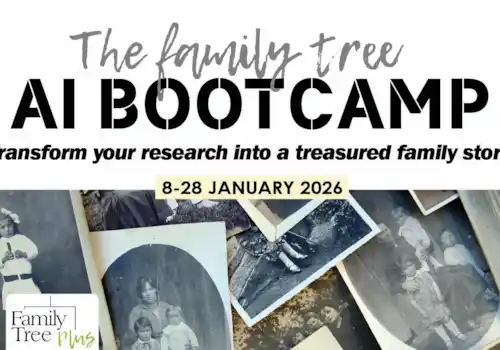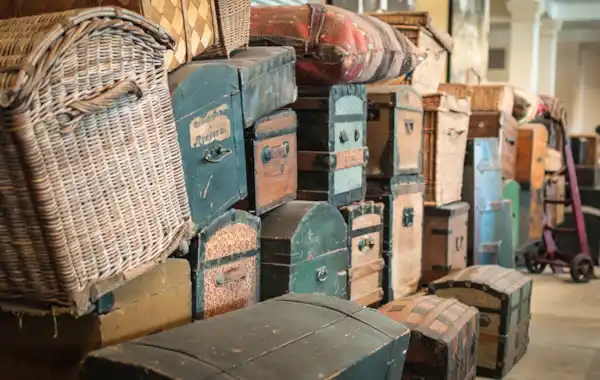Find out how passenger lists can help you find ancestors who travelled to the UK from overseas, or left Britain for a new life in another country.
Passenger lists can be an invaluable source for researching emigration and immigration. If you can’t find someone on the census, passenger lists may be worth a look, in case they were in fact living overseas.
Passenger lists guide: quick links
A background to British passenger lists
It’s an inescapable consequence of living in an island nation that, prior to the advent of air travel, everyone arriving in – or departing from – the country would have done so by sea.
Over the centuries, some efforts were made by the authorities to keep records of those arriving on these shores (there was less interest in those heading in the opposite direction) but it wasn’t until the last few decades of the 19th century that the British government began to maintain anything approaching a comprehensive record of arrivals and departures; even then, the records didn’t cover voyages within Europe.
The National Archives holds a variety of records relating to ‘alien’ arrivals in the UK from 1793 onwards, but these certificates and passenger lists are far from being comprehensive.
There are also good collections of records relating to naturalisation and citizenship, but it’s certainly the case that attempting to find details of people arriving in the UK before 1890 is a bit of a hit-and-miss affair.
The Passengers’ Acts
The requirement to keep records of passengers leaving the UK can be traced back to the Passengers’ Act of 1849.
Unfortunately, only a handful of lists survive before 1890 and other than one isolated survival from 1878, all of those that do survive relate to arrivals in the years 1883 to 1887. And all but one of these early lists relate to ships arriving at the Irish port of Queenstown (Cobh), the one exception being for the RMS City of Rome, which arrived in Liverpool in October 1885.
No outgoing passenger lists survive before 1890.
It should be noted that these lists do not cover voyages that began or ended at ports in Europe or the Mediterranean but, nevertheless, from 1890 until 1960, coverage of incoming and outgoing passenger lists for journeys beginning or ending in other parts of the world is as comprehensive as any set of records like this can be expected to be.
The legislation covered not only passenger ships (defined as ships carrying more than 30 passengers) but also merchant vessels that carried smaller numbers of passengers alongside their usual cargo.
The details to be recorded were set out in the legislation and varied over the years.
By 1890, the lists (both outgoing and incoming) were recording the names and ages of the passengers together with their:
- ‘Profession, Occupation or Calling’
- There were separate columns for ‘English’, ‘Scotch’, ‘Irish’ and ‘Foreigners’
- The lists also recorded the ports of embarkation and landing for each passenger along with details of the ship and of the voyage itself.
- The records also include some non-standard lists, usually those for smaller vessels, many of which record no more than the names of the passengers.
Additional details on later passenger lists
The 1920s and ’30s were a golden age in the history of ocean travel, with thousands of people travelling by ship each year to destinations in all parts of the world.
For a certain class of people, travelling back and forth across the Atlantic became almost a way of life.
And from a family history perspective, the post-World War One records are even more valuable.
Outward lists begin to record the passengers’ ‘Last Address in the United Kingdom’ and those for incoming passengers record their ‘Proposed Address’.
Although relationships aren’t given, with the passengers’ names and ages, listed together in family groups, we can almost use the lists as mini census returns, providing us with a snapshot of the family at times when we might otherwise not have a very clear picture of them.
This is particularly important when we consider the loss of the 1931 Census returns for England and Wales (though that for Scotland survives and is due to be released after the 100 year closure period elapses). If you’re lucky enough to discover a family on a passenger list around this time you’ll find that you have the perfect census substitute.
Most of the post-World War Two lists are typewritten rather than handwritten, making it easier for us to read the details and, perhaps more importantly, making it easier for the people who were employed in transcribing the records to read the details.
From 1955 the lists become even more useful as, instead of their ages, we now get the exact dates of birth of the passengers, both on the incoming and the outgoing lists. Knowing someone’s birthdate is an excellent way of working out whether you’re researching the right person or not.
In addition to the details recorded about the individual passengers, the lists also tell us a great deal about the voyage and about the ships themselves. There’s a wealth of opportunity for further research here.
The standard of record keeping can vary
On the downside, as with just about every set of records we use in our research, the standard of the record keeping varies greatly.
The quality of the handwriting is often an issue as is the frustrating habit that the clerks had of abbreviating the passengers’ first names, sometimes using just initials.
Even more exasperating is the all-too-common practice of entering married women simply as, for example, ‘Mrs. Smith’.
But there’s another way to get into the records and it’s based on an important principle: all journeys have two ends.
If your ancestor sailed from Southampton to New York, you should find a record of their departure in the UK passenger lists, but there’s also a good chance that you’ll find something at the other end of the journey, in the US records.
Ancestry, Findmypast, MyHeritage and FamilySearch all have excellent collections of passenger lists and other associated immigration and emigration records that might add considerably to the story. There are lists covering the USA, Canada, Australia, New Zealand and many other countries to which our ancestors might have travelled.
How to find the passenger lists
Passenger lists created in Britain - inbound
Investigate inbound passenger lists at Ancestry.co.uk, using BT 26 incoming passenger lists for 1878-1960 for ships arriving in Britain from ports outside Europe and the Mediterranean.
Passenger lists created in Britain - outbound
The UK has few records of people who left voluntarily.
Those that do survive are the outward bound passenger lists in BT 27, which contain the names of people leaving the UK from ports in England, Ireland, Scotland and Wales for final destinations outside Europe and the Mediterranean. Findmypast.co.uk and Genes Reunited hold indexes and digitised images of the BT 27 outbound passenger lists from 1890-1960.
The Scottish Emigration Database (free) contains transcripts of records of more than 21,000 passengers who embarked at Glasgow and Greenock for non-European ports between 1 January and 30 April 1923, and at other Scottish ports between 1890 and 1960.
ScotlandsPeople has a digital archive of Highlands and Islands passenger lists, 1852-1857, which can be searched free.
Passenger lists created overseas
Passenger lists created overseas may be found in other archives around the world. Try browsing Cyndi’s List for links on ships and passenger lists at Cyndi's List.
You could also try contacting the major libraries and archives in the country where your ancestor travelled to or from, as they may well hold original records.
Explore America’s official immigration centres 1820-1954 at Castle Garden and Ellis Island.
To trace ancestors who may have arrived at a different port, or who crossed the border from Canada or Mexico, try Joe Beine’s guide at Gene Search, which details US ports of arrival and their available passenger lists 1820-1957 and includes Canadian and Mexican border crossing records.
The National Archives of America has plenty of useful immigration information.
Ancestry has a number of overseas immigration records in its ‘Immigration and Travel’ category, such as passenger arrival records for Canada, North America and Australia, but you are likely to need a worldwide subscription to view them.
Aliens on passenger lists
You can search 300,000 naturalisation records at The National Archives, including Naturalisation case papers, 1789-1934 and 1934-c1968 (not all records survive).
More than 150,000 unique naturalisation and denization records are now available on TheGenealogist with records ranging from 1609 to 1960. As well as providing the date an ancestor may have received British naturalisation or denization, other details may include a change of name when they arrived in the UK.
Explore records of ‘aliens’ at Ancestry.co.uk, using England, Alien Arrivals 1810-1811 and 1826-1869, indexed with digitised images. These include the Aliens Entry Books 1794-1921, which feature Home Office correspondence about aliens, indexes to aliens’ certificates 1836-1852 and applications for naturalisation.
The retired 'Moving Here' website had images of alien certificates issued at the port of Hull 1793-1815. Access an archived version of the site.
Transported convicts
Between 1787 and 1868 more than 160,000 people were transported to Australia. Search records of transportees to Australia, 1787-1879, (including HO10, HO11 and CO209/7) on Ancestry (worldwide subscription required to view records), and search the Ireland to Australia Transportation Database at The National Archives of Ireland.
Passenger lists in 3 easy steps
- Check the BT 26 inwards passenger lists for ancestors who travelled to the UK, and explore the BT 27 outwards passenger lists for ancestors who may have emigrated.
- Consult overseas archives to trace ancestors who travelled to or from another country.
- To find out what information you may be able to find within the records, be sure to read the ‘About’ section for each collection.
Image credit: © Michelle Lee, Attribution-NonCommercial-NoDerivs 2.0 Generic (CC BY-NC-ND 2.0). Originally published February 2015. Reviewed June 2025.
Claim your FREE 1921 Census resource kit
Get family history advice direct to your inbox with the Family Tree Newsletter.
Sign up now and claim your free 1921 Census resource kit!
As a thank you for signing up to the newsletter we'll email you a downloadable resource kit giving you all you need to make the most of the 1921 Census and find out more about your 1920s ancestors.







